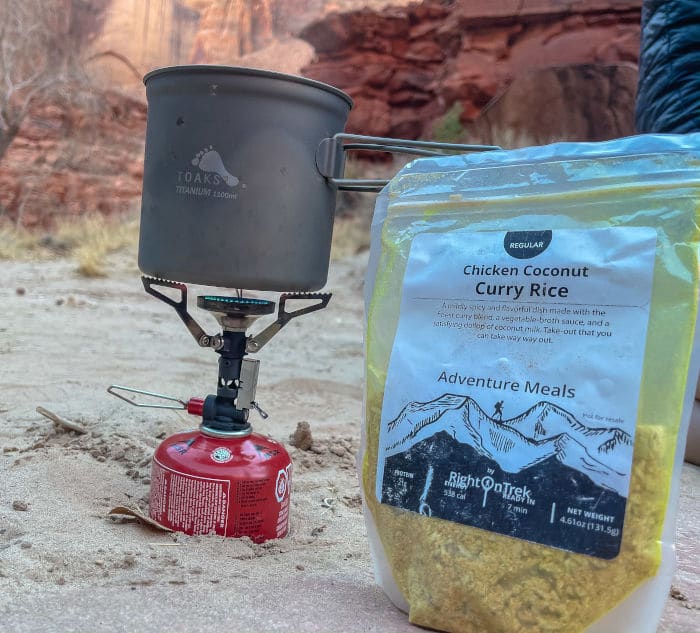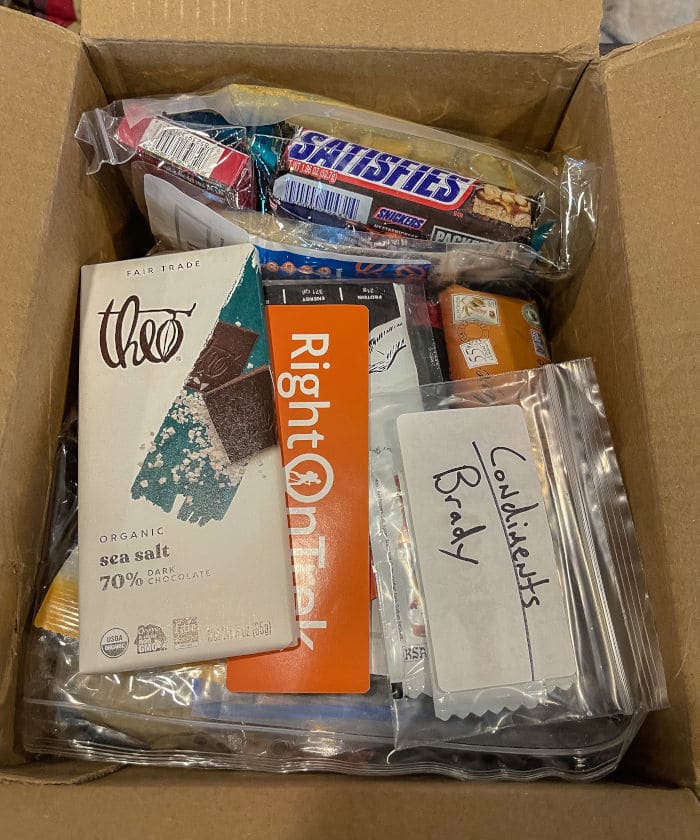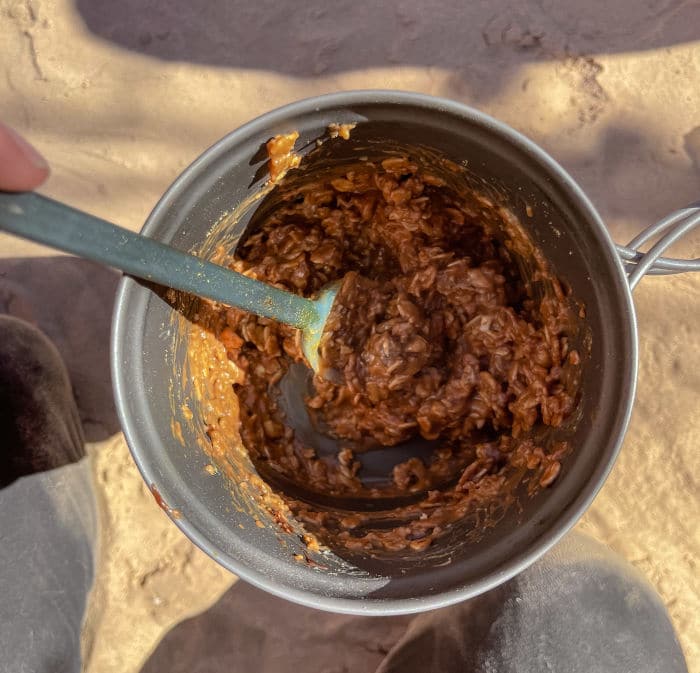At this website, one of our main goals is to help new and inexperienced backpackers feel confident in the outdoors. One of the biggest hurdles for new backpackers is figuring out what and how much food to pack on trips. It needs to be nutritious, tasty, and sufficient enough to fuel you on long, calorie-burning hikes, and for a newbie, none of that stuff is intuitive.
Recently we were approached by a company called Right On Trek that helps reduce some of that food planning stress, and offers a phenomenal service that helps backpackers plan meals. They gave us the opportunity to try it out, and while I’m generally a DIYer who is cautious of letting other people do stuff for me, I was very impressed with Right On Trek.
Right On Trek Overview

Right On Trek is a website that offers a handful of services for hikers, but the one we tried was their meal planning service. It tackles one of the biggest problems that new backpackers face, which is how much and what kind of food to bring on trips. It’s an area that to this day I have difficulties with, and they do an awesome job of making it easy.
Basically, Right On Trek does all your meal planning for you. When you input the details of your hike on their website, they do the rest by supplying awesome meals they make themselves, as well as plenty of delicious snacks, drinks, and even hot sauces.
I find that their service is incredibly valuable for beginners or those short on time. But planning your own meals is also an important skill, so check out my 7-day backpacking meal plan for more information how to do that.
How It Works

Ordering food from Right On Trek is so easy as to be pretty much self-explanatory, but I’ll explain it here just to highlight the ease of use and level of customization they give you.
The first step is to navigate to Right On Trek and click “Start Creating My Custom Meal Plan.” Then you can choose how many days you’ll be on-trail, and whether you’ll need food for just yourself or for a group.
From there you’re taken to a customization page. You start by confirming how many calories per day you’ll need, which defaults to 2400. It totally depends on your trip, but for many first-timers (and for just about any short trip), this is a solid number. If you want to learn more about how to estimate the calories you’ll need for backpacking, check out my post on it.
Once you set your calorie requirements, you’ll be able to specify some preferences, including whether you need vegetarian foods, whether they should include dairy, and whether you like things spicy. You can also select your favorite hot beverages for both breakfast and dinner, and your favorite condiments (we just chose hot sauce, but they also offer salt and pepper, cream, and sugar).
This produces a full meal plan for each day on trail. It will include one breakfast and one dinner per day made by Right On Trek (more details on these below, but they’re delicious) as well as a lunch and snacks made by various other companies. Pretty much everything they put in there is good (you can’t go wrong with snickers, beef jerky, and Tillamook cheese), but if for whatever reason you don’t like an item they add to your plan, you can always swap it out for anything else they have.
If you prefer, you can also eliminate some options so that you have room to bring your own favorites. Check out my post on no-cook backpacking lunches for some ideas on DIY backpacking food.
Price
Once you confirm that you like the plan, you’ll pay for it. It’s surprisingly affordable, with each day costing only around $ 35 plus tax and shipping (shipping is free on orders over $150, which is a 4-5 day trip). The actual cost is $.015 per 1 calorie, but the total calorie count varies slightly from what you input.
Keep in mind that includes one breakfast and one dinner, which if you buy other pre-packaged options would cost around 20-25 dollars alone. Then add some quality snacks like cheese, ProBars, Jerky, and chocolate, and you can easily top 30-35 dollars in value. I’m not sure how they do it (probably bulk discounts and in-house cooking), but it’s legitimately affordable on top of being super convenient.
Speaking of convenience, when they send it to you it’ll come individually packaged by trail day. They do all of this by hand, and it makes it even easier to organize your food when you’re on trail. When you pack up to hike in the morning, you can just throw your food bag for that day in the top of your pack and you’re good to go.
After using Right On Trek’s service, I would trust them with my own meal plan and certainly recommend them to anyone unfamiliar with meal planning for backpacking.
Right On Trek Meals: Taste Tested

The meal planning service is undoubtedly convenient, but how’s the food? Right On Trek makes their own breakfasts and dinners, which you can only get through their service, so it’s definitely worth talking about how their food tastes.
With our order, we got three days’ worth of food for one person. That means three different breakfasts and three different dinners, which I think is plenty to get an idea of whether the food is good or not. The verdict? It’s damn tasty, as long as you’re alright with cooking in an actual pot instead of adding hot water to a freezer bag.
Just to be clear, I wouldn’t quite put it on the same level as some of the premium/gourmet freeze-dried options out there (like Good To-Go or Heather’s Choice), but it isn’t trying to be those. Their meals are fairly basic (but well-flavored) rice and noodle dishes designed to be cooked in a pot, not in the bag. I like that they take this route because while freeze-dried, cook-in-bag meals are nice, they’re usually super expensive. I also think it’s valuable for new backpackers to learn how to cook with a stove and pot. It’s the old-school method and one that can be a lot more satisfying, especially when you start putting together your own recipes (like my top 4 ramen recipes).
The 3 dinners we tried were Chicken Coconut Curry Rice (our personal favorite), Chicken Alfredo Pasta, and General Tsoy’s Mountain Rice. Our breakfasts were their Egg and Cheese Scramble, Cream of Wheat Porridge, and Peanut Butter Cup Oatmeal. As you can see from these titles, they have a ton of variety, and there are even more options if you’re not stoked about one of the ones they choose for you.
Chicken Coconut Curry Rice
Calories: 540
Of the meals we tried, this one takes the cake. I’m a sucker for curry, and they nailed it here. It’s actually pretty similar to my own curry ramen recipe, so it may just be right on par with my personal tastes, but either way, I loved it. It’s also super easy to make (just simmer all ingredients in water), and though it isn’t the most calorie-dense meal, it’s still reasonably high and plenty satisfying.
General Tsoy’s Mountain Rice
Calories: 559
For this one they include olive oil and tamari sauce packets, which lowers the caloric density a bit but gives it an awesome, home-cooking flavor boost. It’s a little on the complicated side, requiring you to add things in three different steps, but it’s still done in about 8 minutes and I personally don’t mind. And as for the taste, it has a nice, tangy, Asian style that I love.
Chicken Alfredo Pasta
Calories: 520
This a solid, comfort-food type meal. It’s not mom’s cooking, but it’s on par with the fancier options and I’d take it backpacking any day. The only thing I should say about this one is that you have to be patient with the noodles, because if you’re like me you’ll end up chowing down too early and run into some crunchiness.
Egg and Cheese Scramble
Calories: 370
I’m generally not a fan of eggs while backpacking. My egg standards are high, and I usually find that making powdered eggs while backpacking just isn’t worth it. These eggs, however, are solid, and it’s probably because they start with olive oil and include hot sauce right in the meal package. They’re still pretty basic, but high-cal for the weight (nearly 150 cal/oz) and plenty satisfying.
Cream of Wheat Porridge
Calories: 330
I’ve never actually eaten cream of wheat before this, so my expectations may have been too high here, but I thought this one was just okay. It’s a little on the bland side on its own , but I think that’s because they deliberately leave room for adding some extra cream and sugar if that’s what you want (which I would do next time). If you prefer porridge less sweet, then you’ll probably like this a lot. The texture is surprisingly great, and it’s also high calorie for the weight and perfectly portioned.
Peanut Butter Cup Oatmeal
Calories: 400
This is the standout of the breakfasts. Though I personally thought it could be a little sweeter (probably thanks to my historical tendency towards those half-sugar-half-oats Quaker packets), I thought the flavor was great and the creamy texture was awesome. As with all their breakfasts, it’s super calorie-dense and super satisfying.
Conclusion
Overall Right On Trek is a great company that makes great food. The meals are tasty, calorie-dense, and full of whole food ingredients. And most importantly, they do an awesome job at making meal planning easy and convenient. I would recommend them as a starting point for any new backpacker, or anyone who hates planning and wants to try some new foods.
If you found this review valuable and would like to use Right On Trek's meal planning service, we'd love it if you order through our affiliate link (link here). We get a small kickback and it helps us continue to provide honest reviews and detailed guides for you. Thank you for your support!
